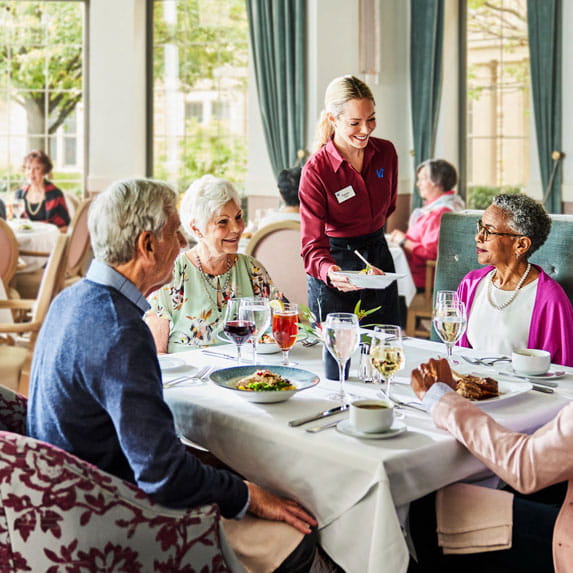Continuing Care Retirement Communities (CCRCs)
Continuing-care retirement communities (CCRCs), also known as Life Plan Communities, take an all-in-one approach to senior living. All of Vi’s 10 locations are Life Plan Communities!
Typically, residents can expect to have access to some combination of independent living, assisted living, skilled nursing, and memory care.
These communities pack a lot of value:
- Residents enjoy an independent lifestyle with the freedom to pursue their passions and favorite activities
- Community living offers an opportunity for social connectedness with extraordinary peers
- Many communities offer opportunities for lifelong learning and enticing cultural experiences
- Around-the-clock staff is on hand for service and safety
- A low-maintenance lifestyle means no HOA dues, stacks of bills to pay, home and landscape maintenance, and more
- Residents have a plan in place for future care

Under this umbrella, there are three types of Life Plan Communities: Inclusive, Modified and Fee-For-Service. They differ in how residents pay for the care they receive.
Some communities offer multiple contract options to suit residents’ varying care and financial needs.
Rental senior living communities
Similar to CCRCs, rental senior living properties offer an independent lifestyle with plenty of opportunities to make new friends and enjoy low-maintenance living.
In these communities, residents simply sign a lease, pay their security deposit and move in.
They have a low entry cost compared to CCRCs, for one major reason: Rental communities don’t provide guaranteed access to future care. They may partner with standalone assisted living, memory support, and skilled-nursing facilities, but rental properties generally don’t provide care services and don’t include those services in the cost.
Aging in place at home
Aging in place is defined as “the ability to live in one's own home and community safely, independently and comfortably.”
Many seniors wish to remain at home for as long as possible to hang on to the familiarity and comfort of the home they’ve known for years.
There are benefits to aging in place, including staying close to friends and family, maintaining your daily routines, access to the same country clubs and community organizations, and more.
There are a few additional factors to consider, though:
- It can be increasingly difficult to keep up with home upkeep and landscaping tasks as you age.
- Remaining at home can become lonely as neighborhood residents change over time and driving from place to place gets harder.
- If you eventually need care services, you and your family will need to vet caregivers in the moment when stress may already be running high.
- The costs of in-home care fluctuate based on many variables.
We hear from a lot of seniors and their families as they compare the options in front of them. If you have a list of questions, you’re not alone!
Our team is available to chat with you and answer some of those questions. Fill out this short form to have us get in touch with you.
Glad to be connected!
There’s a lot to consider when embarking on the next phase of retirement—and contacting us is a big step. (Well done!)
We’ll be in touch soon to share expert insights and resident perspectives that we hope are helpful, and one of our team members will also be reaching out to answer any questions you may have.
